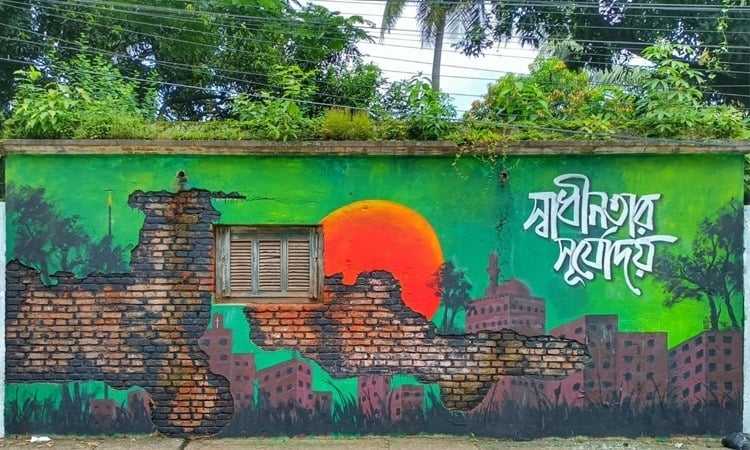On the night of July 17 last year, the nation held its breath. Asif Mahmud Shojib Bhuyain, once a student leader and now an adviser to the interim government, took to Facebook and made a bold declaration that reverberated through every corner of the country:
“I declare a complete shutdown across the country for tomorrow, July 18.” It was not a suggestion—it was a call to arms.
Shojib’s post, published around 8 p.m. on that fateful evening, came in direct response to a day of violence unleashed by law enforcement agencies—police, RAB, BGB, and even SWAT—on peaceful students gathering at Dhaka University (DU) to hold a gayebana janaza (funeral prayer in absentia) for six people, including three fellow students, killed the day before on July 16.
“No shops will open. No vehicles except ambulances will move. Only hospitals and emergency services will operate,” Shojib wrote. “Students from all institutions—schools, colleges, universities, madrasahs—and guardians, rise. The future of this country depends on your courage tomorrow.”
Earlier that afternoon, the DU campus had turned into a war zone. Students from different halls arrived at the Raju Memorial Sculpture, carrying symbolic coffins to honor their fallen. But they never made it. At 2:30 p.m., police swarmed in, lobbing sound grenades, tear gas, and rubber bullets to scatter the peaceful procession.
Still, the students would not retreat. At 4:00 p.m., defiant and grieving, they held the janaza in front of the Vice Chancellor’s residence, surrounded by barricades and the ruins of tear gas shells. “We will not let this movement die. We will not stop until our demand is met,” they chanted in unison, fists raised skyward.
But when they tried to march toward TSC, police struck again.
“The entire campus was blocked. We were attacked from all sides,” said Sarjis Alam, another key leader of the anti-quota movement, his voice shaking with rage and exhaustion.
As the nation watched in disbelief, the government’s grip tightened. All mobile operators were ordered to shut down internet services nationwide—cutting off the movement’s lifeline.
The night of July 16 had already lit the spark. Protesters had overrun Chhatra League strongholds in DU halls, forcing the ruling party’s student wing to retreat. Fourteen hall provosts were compelled to declare student politics banned within their premises.
The University Grants Commission, desperate to regain control, ordered the closure of all educational institutions, asking students to vacate halls “for security reasons.” Dhaka University followed suit, declaring closure sine die, with a deadline of 6 p.m. for all students to leave.
“We’re not leaving. We’re not backing down. This campus is ours,” shouted students from the rooftops, waving black flags and chanting “Joyotar lorai cholbei” (The fight for justice will go on).
Evening fell, and all eyes turned to the streets of Jatrabari. There, ordinary citizens—men, women, youths—rose in rebellion. The pain of the fallen, the anger of injustice, and the courage of defiance collided in one powerful surge.
When police opened fire on mourners protesting the attack on DU students, injuring at least six, the people fought back. They torched the toll plaza at the Kajla end of the Mayor Hanif Flyover, a fiery declaration that the streets no longer belonged to fear.
That blaze in Jatrabari would become symbolic—the first flame of the people’s uprising that would ultimately culminate in the fall of the fascist regime on August 5.
The then Prime Minister Sheikh Hasina addressed the nation, calling on students to “wait for the court’s verdict.” But her voice failed to resonate. Protesters rejected her speech outright.
Other leaders lashed out. Liberation War Affairs Minister AKM Mozammel Haque warned that the movement had been “hijacked by anti-liberation forces,” while Awami League General Secretary Obaidul Quader called on his party members to mobilize:
“This is an attack on our existence. Get organized in every ward.”
Earlier that day, the nation laid its first martyr of the movement, Abu Sayeed, to rest at his ancestral home in Pirganj, Rangpur. The mourning spread like wildfire. Gayebana janaza was held across the country—from Begum Rokeya University to the Baitul Mukarram National Mosque, even as police tried to halt them.
The protests on July 17 may have fallen on the holy day of Ashura, but the grief and fury of a betrayed generation turned the day into something else—a national reckoning.
From city streets to rural villages, the message was clear: The blood spilled on the university steps would not be forgotten.
And as the smoke rose above Jatrabari that night, it carried with it the first scent of revolution.


